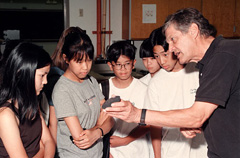![[Currents header graphic]](http://www.ucsc.edu/homeart/currents_header.gif)
![[Currents header graphic]](http://www.ucsc.edu/homeart/currents_header.gif)
August 24, 1998

|
|
Sudents from Saratoga's Redwood Middle School toured the SCIPP lab, where adjunct professor of physics Hartmut
Sadrozinski showed them a device used to detect subatomic particles (More photos).
|
By Tim Stephens
Three local high school teachers are getting hands-on experience in a high-energy physics lab through a summer research program with the Santa Cruz Institute for Particle Physics (SCIPP) at UCSC.
After eight weeks as summer research associates in the SCIPP laboratory, the teachers will head back to their classrooms ready to help students make a connection between the material in their textbooks and the real work of cutting-edge physicists.
"We're not just making up things for (the teachers) to do, we are really immersing them in our research program," said Hartmut Sadrozinski, adjunct professor of physics and coordinator of the summer research associates program.
Deirdre Roberts, a physics and biology teacher at North Monterey County High School in Castroville, said her students may not be able to understand some of the highly technical aspects of the research at SCIPP, but they can certainly relate to its ultimate goals. She is particularly excited about working on the Gamma Ray Large Area Space Telescope (GLAST) project.
"Kids just love astronomy and space projects, especially anything having to do with black holes, so it will be great to bring some of this material back to the classroom," Roberts said.
The teachers are also participating in research and development related to the ATLAS project, a major international experiment involving 1,700 collaborators in 144 institutes around the world. SCIPP researchers are preparing sensitive electronic devices for the ATLAS particle detectors, which will be used in the Large Hadron Collider (LHC) at the European Laboratory for Particle Physics (CERN) in Geneva, Switzerland.
The summer program for teachers is funded partly through the ATLAS project and also through the campus as part of Industry Initiatives for Science and Math Education (IISME). IISME is a nonprofit collaborative of San Francisco Bay Area corporations, universities, government agencies, and local educators seeking to improve math and science education by working with teachers in the K-14 system.
This is the first year SCIPP has brought middle and high school teachers into the lab. The aim is not to teach them the details of particle physics, but to enable the teachers to draw on the most current and relevant research to gain the interest of students in learning physics.
In addition to the three teachers working in the SCIPP lab this summer, another IISME fellow, Zach Grinspan, has been working in the biophysics research laboratory of Dean David Kliger, professor of chemistry. Grinspan, a math and computer science teacher at James Lick High School in San Jose, has been studying the binding of oxygen by hemoglobin.
"The idea is to get teachers excited, help them understand the science and technology, and then they can translate it to their students," Sadrozinski said.
As part of the IISME program, the teachers will prepare a written plan for how to translate their summer work experience to the classroom. Mia Onodera, who teaches eighth-grade math at Redwood Middle School in Saratoga, quickly made plans to bring her students to the SCIPP lab for a tour. Eight of her students visited the lab in early August and got to use lasers and other high-tech equipment.
Nancee Boice, who in addition to being a summer research associate taught geometry this summer at Soquel High School, is developing a series of activities for students to do before and after a visit to the lab. Her ideas include a "Particle Zoo Game" to introduce the concept of subatomic particles. She also plans to create a Web site where other teachers can find resources for physics activities.
Sadrozinksi said he hopes to expand the program in future years to give more teachers the opportunity to get involved in physics research at SCIPP.